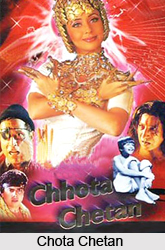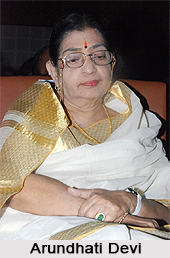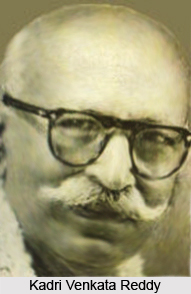 Telugu directors started by directing mythological movies. In fact this film industry shows a preference for mythological movies before tackling melodrama or social drama. Thus one of the southern pioneers, Hanumappa Muniappa Reddy, directed the first Telugu movie, Bhakta Prahalada in 1931. The story of the film was borrowed from the Puranas. It was an instant success. His next directorial venture was a humorous film, Tenali Ramakrishnan (1941), based on the life of Tenali Raman, a hero of popular local tales, and is both a historical film and moral tale.
Telugu directors started by directing mythological movies. In fact this film industry shows a preference for mythological movies before tackling melodrama or social drama. Thus one of the southern pioneers, Hanumappa Muniappa Reddy, directed the first Telugu movie, Bhakta Prahalada in 1931. The story of the film was borrowed from the Puranas. It was an instant success. His next directorial venture was a humorous film, Tenali Ramakrishnan (1941), based on the life of Tenali Raman, a hero of popular local tales, and is both a historical film and moral tale.
Another Telugu director who is known to make mythological films is Chittajallu Pullaiah. He was trained at Mumbai and Kolkata in filmmaking before he returned to South India. He made Lavakusa (1934) and Mohini Bhasmasura (1938). The latter was shot in superb countryside. In 1939 Pullaiah chose reformist content with Varavikrayam which attacks the iniquitous dowry system. Then came Balanagamma (1942), a type of spectacular comedy based on the local popular theatre. The film featured one of the greatest Telegu actresses, Anjali Devi.
Gudavalli Ramabrahman inaugurated the political film in 1938 with Malapilla. The film was directed against the dogmatism of the Brahmins and the caste system through the story of an untouchable girl who falls in love with a Brahmin boy. The following year, he attacked the big landed zamindars, exploiters of tenant farmers, in Raitu Bidda. The 1930s and the 1940s were also illustrated by Hanumappa Vishewanath Babu. He was the creator of pioneering production company Saraswathi Talkies and the director of Draupadi Vastrapaharanam (1936). The film featured the great actress and singer Pasupuleti Kannamba. The film was inspired from the Hindu epic Mahabharata.
Tatieni Prakash Rao has illustrated a brief Telugu `Golden Age` through three films in particular. His 1952 film, Palleturu, is a rural melodrama which was an enormous success, portraying the battle between modern consciousness and superstitions, starving peasants and moneylenders. His other film Amara Deepam (1956) was shot in Tamil.
Kadaru Nagabhushanam left two films behind him that are worth watching. Navajeevan (1949) in Telugu is a nationalist film on the Tamil DMK wavelength supported by the outstanding Telegu actor and singer Chittoor V Nagaiah. His other noteworthy film is Pederaitu (1952). It is a rural tragedy that ends with the redistribution of the lands of the zamindars to the poor peasants.
The Telugu director Bommireddi Narasimha Reddi made Devatha, a melodrama which ends nearly well after having related contrary love affairs and the fault of a cunning maid servant seduced by the young man of the family. One of his best films, Swargaseema (1945) is an accomplished melodrama inspired by Pygmalion by Bernard Shaw. It was in madras that he directed one of the classic Telugu Films, Malleshwari (1951). This delightful and expensively produced historical fantasy is drawn from a popular romantic tale and set in the period of the glorious southern Hindu dynasty of Vijayanagara. Poojaphlam(1964), Bangaru Panjaram (1965) and Rangula Ratnam (1966) are his other films.
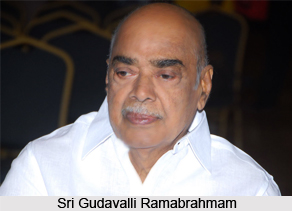 P Pullaiah was active till 1975. He has made several mythological films as well as melodramas. His filmography includes Sankranti (1952), Siri Sampadalu (1962) and others. Apart from them LV Prasad is one of the greatest pioneers for the talkie. This Telegu director is the recipient of Dada Saheb Phalke Award in 1982. His speciality is the conjugal dramas in the middle class. One such film is Pelli Chesi Choodu featuring NTR. His other directorial venture was Poongothai with Shivaji Ganesan and the Telugu actor A Nageswara Rao. It portrays the story of incest. He is one of those rare directors of Indian cinema who has delivered one commercial success after the other. One finds NT Rama Rao or NTR again in a village comedy, Missamma (1955).
P Pullaiah was active till 1975. He has made several mythological films as well as melodramas. His filmography includes Sankranti (1952), Siri Sampadalu (1962) and others. Apart from them LV Prasad is one of the greatest pioneers for the talkie. This Telegu director is the recipient of Dada Saheb Phalke Award in 1982. His speciality is the conjugal dramas in the middle class. One such film is Pelli Chesi Choodu featuring NTR. His other directorial venture was Poongothai with Shivaji Ganesan and the Telugu actor A Nageswara Rao. It portrays the story of incest. He is one of those rare directors of Indian cinema who has delivered one commercial success after the other. One finds NT Rama Rao or NTR again in a village comedy, Missamma (1955).
Kadri Venkata Reddy is one of the best illustrators of the major genres of Telugu cinema in the 1950s and 60s. His mythological films like Maya Bazar (1957) and action films wee larded with folklore. He as often relied on the great actor and musician Chittoor Nagaiah, a specialist in portraying saints in films. He has also directed films which Kadri Venkata Reddy produced. Reddy also uses the mythical NT Rama Rao in his spectacularly successful Patal Bhairavi (1951). Pedda Manushulu (1954) is a profoundly Indianised adaptation of Ibsen.
Shri Krishna Satya (1971), Bhagyachakram (1968), Umachandi Gauri Shankarula Katha (1968), Satya Harishchandra (1965), Sri Krishnarjuna Yudham (1962), Jagadeka Veeruni Katha (1961), Jagathala Prathapan (1961), Vazhkai Oppantham (1959), Pelli Naati Pramanalu (1958), Donga Ramudu (1955), Gunasundari Katha (1949), Yogi Vemana (1947) and Bhakta Potana (1942) are his other films as a Telugu director.
PS Ramakrishna Rao directed Ratnamala (1947) and Vipranarayana (1954). Another prolific Telugu director is Kamalakara Kameshwara Rao. He is known for his memorable films like Chandraharan (1953), a fairy tale in costumes featuring NT Rama Rao. In 1962 he made a historical film, Mahamantri Timmarasu, which is about the brilliant dynasty of Vijayanagara. Sri Krishnavataram is another mythological film of this Telugu director with NT Rama Rao.
Of Kovalapati Surya mention must be made of Kanna Talli (1953), a family melodrama whose heroine represents the mother courage. Apart from this another Telugu director who has contributed to the Telugu film industry is Kottayya Pratyagatma. He directed two interesting films. One was a musical melodrama, Kulagothralu (1962) and Punajanma (1963).
Active until 1976, Adhurti Subba Rao has directed films with semi realist content like Moogamanushulu (1963). It is a successful musical film about the love affair of a boatman of the Godavari River and a woman of higher social class. The situation is presented in view of a social scandal and has the theme of reincarnation. Maro Prapancham (1970) has a social theme dealing with poverty.
One of the prominent Telugu directors in Indian cinema is Bapu or Sattiraju Lakshminarayan. His films set themselves apart in their treatment of the native Telugu people. He captures their nativity and transforms them on celluloid. The subjects of his films are often realistic family issues, relationships, magic realism with vignettes of mythological characters. Most of his films have the female actors as the protagonists. This was a breakaway from the formula of the then Telugu films.
Some of his other films are
| Saakshi (1967) |
Vamsa Vriksham, (1980) |
Pelli Pustakam (1991) |
| Bangaru Pichika (1968) |
Tyagayya (1981) |
Pelli Koduku, (1994) |
| Buddhimanthudu (1969) |
Pelleedu Pillalu (1982) |
Pramaatma (1994) |
| Inti Gowravam (1970) |
Edi Dharmam Edi Nyayam (1982) |
Radha Gopalam (2005) |
| Andhala Ramudu (1973) |
Bullet (1985) |
Sundarakanda (2008) |
| Sneham (1977) |
Jackie (1985) |
|
| Gorantha Deepam (1978) |
Kalyana Thamboolam (1986) |
|
He has also directed Bollywood films as well.
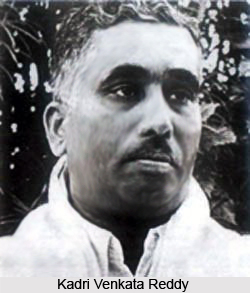
Kashinadhuri Vishwanath preferred themes based on classical music and dance. His 1973 film, Sharada, is a convincing psychodrama about madness, then six years later, Shankarabharanam (1979) was released. This film portrayed the relation of a guru and a danseuse who has become a prostitute. It was an immense success owing to its music and dance. Sagara Sangamam (1983) featured
Kamal Hassan in a role of an outstanding dancer obsessed with the aesthetics of classical dance.
Srinivas Singitham Rao is one of the rare representatives of the Telugu New Cinema. In 1977 he directed Taram Marindi which portrays the brutality of social relationships in a village throiugh the forced marriage of a young girl with an aged and alcoholic widower. In 1985 SS Rao made Mayuri, a classical dancer who fights her handicap when leg is amputated and who decides to continue to dance with an artificial leg. Rao`s work is charactersied by a lively and precise camera, outstanding in some films, like
Pushpak. It was a black humour with Kamal Hassan playing an unemployed man dreaming of becoming rich. The film was a phenomenal success.
Born in 1946, another contemporary director is Bongu Narsingha Rao. His critically acclaimed Rangula Kala (1983) is a beautiful existential drama which brings together a painter, an auto rickshaw driver and a Marxist journalist. It is a socio political introspection of the 1980s. Then Daasi (1988) is one of the best films in the history of Telugu cinema which attacks the subjugation of women through a story set in the 1920s. His other film is Matti Manushulu (1990). It was truly an art film.
Besides these Telugu directors the new crop of filmmakers are equally talented and have contributed hugely to the growth and popularity of the Telugu film industry. Krishna Vamsi is considered one of the most creative directors of Indian cinema. He has won National awards twice in his lifetime. Gulabi, Ninne Pelladatha, Sinduram, Chandraleka, Anthahpuram, Samudram, Murari, Khadgam, Shakti, Sri Anjaneyam, Chakram, Danger, Rakhi, Chandamama and others are some of his films.
NT Rama Rao needs no introduction. A prolific actor of his age he also ventured into direction.
Other prominent Telugu directors of Indian cinema are as follows:
| V. N. Aditya |
Pawan Kalyan |
Dasari Narayana Rao |
| Bhaskar |
Sekhar Kammula |
K. Raghavendra Rao |
| K. Vijaya Bhaskar |
Karunakaran |
Kodandarami Reddy |
| YVS Chowdary |
Katta Subba Rao |
H. M. Reddy |
| Puri Jagannath |
Deva Katta |
S. V. Ranga Rao |
| Jaya Krishna |
Neelakanta |
Prabhu Deva Sundaram |
| K S R Swamy |
Vamsi Paidipally |
V. V. Vinayak |
| Kadri Venkata Reddy |
S. Ranga |
Chandra Sekhar Yeleti |
 Telugu directors started by directing mythological movies. In fact this film industry shows a preference for mythological movies before tackling melodrama or social drama. Thus one of the southern pioneers, Hanumappa Muniappa Reddy, directed the first Telugu movie, Bhakta Prahalada in 1931. The story of the film was borrowed from the Puranas. It was an instant success. His next directorial venture was a humorous film, Tenali Ramakrishnan (1941), based on the life of Tenali Raman, a hero of popular local tales, and is both a historical film and moral tale.
Telugu directors started by directing mythological movies. In fact this film industry shows a preference for mythological movies before tackling melodrama or social drama. Thus one of the southern pioneers, Hanumappa Muniappa Reddy, directed the first Telugu movie, Bhakta Prahalada in 1931. The story of the film was borrowed from the Puranas. It was an instant success. His next directorial venture was a humorous film, Tenali Ramakrishnan (1941), based on the life of Tenali Raman, a hero of popular local tales, and is both a historical film and moral tale.
 P Pullaiah was active till 1975. He has made several mythological films as well as melodramas. His filmography includes Sankranti (1952), Siri Sampadalu (1962) and others. Apart from them LV Prasad is one of the greatest pioneers for the talkie. This Telegu director is the recipient of Dada Saheb Phalke Award in 1982. His speciality is the conjugal dramas in the middle class. One such film is Pelli Chesi Choodu featuring NTR. His other directorial venture was Poongothai with Shivaji Ganesan and the Telugu actor A Nageswara Rao. It portrays the story of incest. He is one of those rare directors of Indian cinema who has delivered one commercial success after the other. One finds NT Rama Rao or NTR again in a village comedy, Missamma (1955).
P Pullaiah was active till 1975. He has made several mythological films as well as melodramas. His filmography includes Sankranti (1952), Siri Sampadalu (1962) and others. Apart from them LV Prasad is one of the greatest pioneers for the talkie. This Telegu director is the recipient of Dada Saheb Phalke Award in 1982. His speciality is the conjugal dramas in the middle class. One such film is Pelli Chesi Choodu featuring NTR. His other directorial venture was Poongothai with Shivaji Ganesan and the Telugu actor A Nageswara Rao. It portrays the story of incest. He is one of those rare directors of Indian cinema who has delivered one commercial success after the other. One finds NT Rama Rao or NTR again in a village comedy, Missamma (1955).
 Kashinadhuri Vishwanath preferred themes based on classical music and dance. His 1973 film, Sharada, is a convincing psychodrama about madness, then six years later, Shankarabharanam (1979) was released. This film portrayed the relation of a guru and a danseuse who has become a prostitute. It was an immense success owing to its music and dance. Sagara Sangamam (1983) featured Kamal Hassan in a role of an outstanding dancer obsessed with the aesthetics of classical dance.
Kashinadhuri Vishwanath preferred themes based on classical music and dance. His 1973 film, Sharada, is a convincing psychodrama about madness, then six years later, Shankarabharanam (1979) was released. This film portrayed the relation of a guru and a danseuse who has become a prostitute. It was an immense success owing to its music and dance. Sagara Sangamam (1983) featured Kamal Hassan in a role of an outstanding dancer obsessed with the aesthetics of classical dance.
